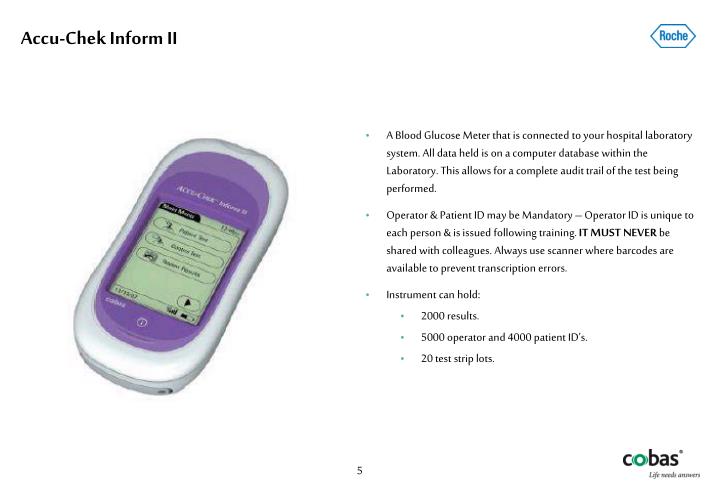
ACCU CHEK INFORM II TEST CODE
Accu-Chek Inform II glucometer displays the blood glucose as a numeric value, which is the expected format, along with an alarm code of W-511 Out of Critical Range (source of photo: VHA8). Thus, the VHA conducted a study to determine the safest way to configure the Accu-Chek Inform II glucometers that would lead to the fewest treatment errors. Figure 2 provides an example of 1 of these 2 configurations with alarm code W-511. Two of the 6 configurations will display a numeric blood glucose value (e.g., 32 mg/dL), 1 of which will include a numeric alarm code. Figure 1 provides an example of 1 of these 4 configurations, RR LO with alarm code W-510. For example, for a blood glucose value of 32 mg/dL, 4 of the 6 configurations will display an out-of-range abbreviation (CR LO or RR LO)-2 of which will include a numeric alarm code.

The Accu-Chek Inform II can display critical blood glucose levels 6 different ways depending on glucometer configuration. The "510" in the alarm code has been mistaken as the blood glucose value, leading to incorrect administration of insulin (source of photo: VHA8). Accu-Chek Inform II glucometer displays the blood glucose with an abbreviation, RR LO (out of reportable range low limit) and an alarm code, W-510 Out of Reportable Range, below the abbreviation. In the fatal event, the practitioner expected a numeric blood sugar value to appear on the results screen, so the numeric portion of the alarm code, W-510 ( Figure 1), was presumed to be the patient’s blood glucose value. 10,11 Insulin was incorrectly administered to both patients, one of whom died. 9 Two other events occurring within 3 months of each other involved the abbreviation RR LO, which was also misinterpreted as a high blood glucose reading. One error occurred when CR LO was misinterpreted as a high blood glucose reading, and insulin was incorrectly administered to the patient. In the events reported to FDA, practitioners misinterpreted the results on the glucometers when the blood glucose was displayed using an out-of-range abbreviation, such as RR LO (out of reportable range low limit) or CR LO (out of critical range low limit), and/or when numeric alarm codes (e.g., W-510) were displayed in a pop-up message. These events involved mistakes in interpreting patients’ blood glucose levels due to the way the results were displayed on some glucometer screens, including ACCU-CHEK Inform (no longer available from the manufacturer) and ACCU-CHEK Inform II (Roche Diagnostics), a commonly used POC glucometer by the VHA. The study was conducted in response to multiple adverse events reported to the US Food and Drug Administration (FDA) since 2010. In a more recent study conducted by the Veterans Health Administration (VHA), 8 a different type of error was described. 3 Other factors that can affect POC glucose test results include hematocrit, ascorbic acid levels, 4 and other sugars such as maltose, 5 including maltose-containing medications or parenteral solutions. 3 In the latter case, a study in a neonatal unit showed that staff failed to confirm two patient identifiers for 45% of the POC tests performed.

For example, earlier studies have found that the most common types of errors associated with POC glucose testing are related to delays in testing due to the unavailability of trained staff 2 and a failure to positively identify patients prior to testing. 1 While POC glucose testing offers immediate results that can be used to make important clinical decisions about the treatment of hypo- or hyperglycemia, errors can occur at any point in the testing process.

Problem: Glucose testing is one of the most frequent point-of-care (POC) tests performed in hospitals.


 0 kommentar(er)
0 kommentar(er)
